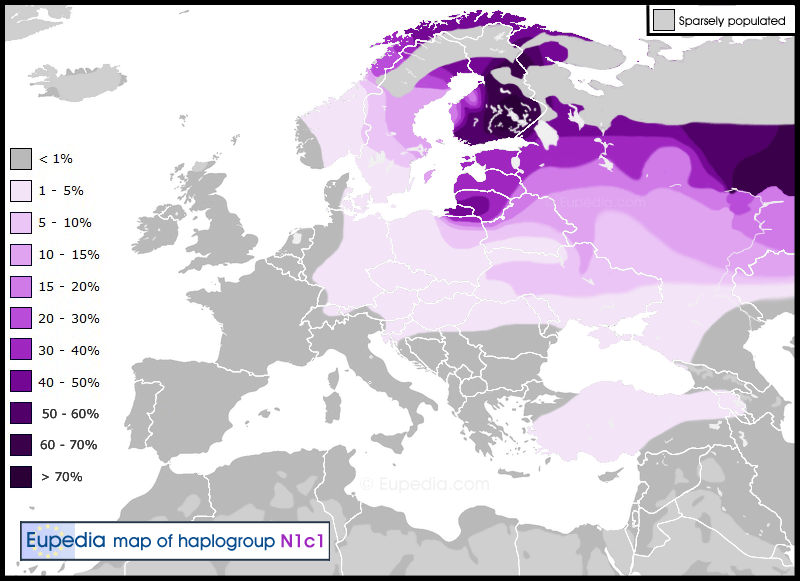Must we do site and academic searches for our posters, and conduct tutorials as well? This is getting tiresome.
From Eupedia, but similar information can be found in other web sites and academic publications:
Haplogroup
N1c is found chiefly in north-eastern Europe, particularly in Finland (61%), Lapland (53%), Estonia (34%), Latvia (38%), Lithuania (42%) and northern Russia (30%), and to a lower extent also in central Russia (15%), Belarus (10%), eastern Ukraine (9%), Sweden (7%), Poland (4%) and Turkey (4%). N1c is also prominent among the Uralic speaking ethnicities of the Volga-Ural region, including the Udmurts (67%), Komi (51%), Mari (50%) and Mordvins (20%), but also among their Turkic neighbours like the Chuvashs (28%), Volga Tatars (21%) and Bashkirs (17%), as well as the Nogais (9%) of southern Russia.
N1c represents the western extent of haplogroup N, which is found all over the Far East (China, Korea, Japan), Mongolia and Siberia, especially among Uralic speakers of northern Siberia. N1c reaches a maximum frequency of approximately 95% in the Nenets and Nganassans, two Uralic tribes of central-northern Siberia, and 90% among the Yakuts, a Turkic people who live mainly in the Sakha (Yakutia) Republic in central-eastern Siberia.
Author: Maciamo. Last update April 2014
Geographic distribution
Haplogroup
N1c is found chiefly in north-eastern Europe, particularly in Finland (61%), Lapland (53%), Estonia (34%), Latvia (38%), Lithuania (42%) and northern Russia (30%), and to a lower extent also in central Russia (15%), Belarus (10%), eastern Ukraine (9%), Sweden (7%), Poland (4%) and Turkey (4%). N1c is also prominent among the Uralic speaking ethnicities of the Volga-Ural region, including the Udmurts (67%), Komi (51%), Mari (50%) and Mordvins (20%), but also among their Turkic neighbours like the Chuvashs (28%), Volga Tatars (21%) and Bashkirs (17%), as well as the Nogais (9%) of southern Russia.
N1c represents the western extent of haplogroup N, which is found all over the Far East (China, Korea, Japan), Mongolia and Siberia, especially among Uralic speakers of northern Siberia. N1c reaches a maximum frequency of approximately 95% in the Nenets and Nganassans, two Uralic tribes of central-northern Siberia, and 90% among the Yakuts, a Turkic people who live mainly in the Sakha (Yakutia) Republic in central-eastern Siberia.
Distribution of haplogroup N1c in Europe
Subclades
Note that N1c was known as N3 and N1c1 as N3a in the official phylogeny prior to 2008.
- N1c (L729)
- N1c1 (M46/Page70/Tat)
- N1c1a (M178): found in Siberia
- N1c1a1 (L708): found in the Volga-Ural region
- N1c1a1a (L392, L1026): found throughout north-east Europe
- N1c1a1a1 (CTS2929/VL29): found in Russia (incl. Volga-Ural), the Baltic, Sweden and Hungary
- N1c1a1a1a (L550): found throughout the Baltic and North Slavic countries, and in places settled by the Vikings
- N1c1a1a1a1 (L1025): found especially in Balto-Slavic countries, with a peak in Lithuania and Latvia
- N1c1a1a1a1a (L149.2, L551)
- N1c1a1a1a1b (L591)
- N1c1a1a1a1c (L1027)
- N1c1a1a1b (L1022): found throughout north-east Europe, especially in Finland
- N1c1a1a2 (Z1936)
- N1c1a1a2a (Z1925, Z1935): found in Finland, Lapland, Scandinavia, the Volga-Ural and the Altai
- N1c1a1a2b (L1034): found in and around Hungary and in Central Asia (Kazakhstan). Ugric subclade.
- N1c2 (L666): found in Russia
- N1c2a (M128)
- N1c2b (P43): found in the Volga-Ural region
- N1c2b1 (P63)
- N1c2b2 (L665)
Origins & History
Haplogroup N is a descendant of East Asian macro-haplogroup NO. It is believed to have originated in Indochina or southern China approximately 15,000 to 20,000 years ago.
Haplogroup N1* and N1c were both found at high frequency (26 out of 70 samples, or 37%) in Neolithic and Bronze Age remains (4500-700 BCE) from the West Liao River valley in Northeast China by Yinqiu Cui et al. (2013). Among the Neolithic samples, haplogroup N1 made up two thirds of the samples from the Hongshan culture (4700-2900 BCE) and all the samples from the Xiaoheyan culture (3000-2200 BCE), hinting that N1 people played a major role in the diffusion of the Neolithic lifestyle around Northeast China, and probably also to Mongolia and Siberia.
The N1c1 subclade found in Europe likely arose in Southern Siberia 12,000 years ago, and spread to north-eastern Europe 10,000 years ago. It is associated with the Kunda culture (8000-5000 BCE) and the subsequent Comb Ceramic culture (4200-2000 BCE), which evolved into Finnic and pre-Baltic people.
The Indo-European Corded Ware culture (3200-1800 BCE) progressively took over the Baltic region and southern Finland from 2,500 BCE. The merger of the two gave rise to the hybrid Kiukainen culture (2300-1500 BCE). Modern Baltic people have a roughly equal proportion of haplogroup N1c1 and R1a, resulting from this merger of Uralic and Slavic cultures.
A small percentage of N1c1 is found among all Slavic, Scandinavian populations, as well as in most of Germany (except the north-west). Its origin is uncertain at present, but it most probably spread with the Iron Age and early Medieval (Proto-)Slavic tribes from Russia, Belarus and Ukraine toward East Germany. The Scandinavian N1c1 has three potential sources:
- 1. Progressive assimilation of the northern Sami populations by Scandinavian/Germanic people since the Iron Age
- 2. Immigration from Germany and Poland in the last two millennia.
- 3. Population exchange with Finland and the Baltic countries when these came under Scandinavian rule, particularly during the eight centuries of political union between Sweden and Finland.



